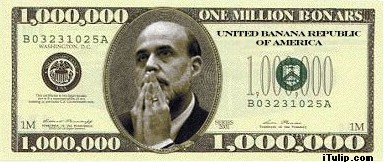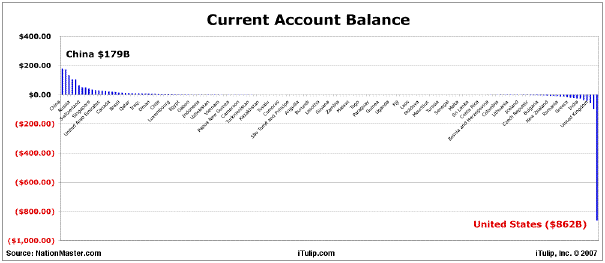 |
by Eric Janszen
The sliding US dollar is making headlines again. American friends of ours just canceled a vacation trip to Europe because of the unfavorable euro to dollar exchange rate, at US$1.40 as we write. Expense was only part of the reason. The main reason? "It's humiliating," he told us.
This is the first of a several quick comments on the dollar to put the crisis facing the dollar into perspective. We address the questions, What's pushing the dollar down? Why now? Where is the dollar headed long term?
We start with a look at a major factor, the United States' current account.
Current Account
The current account is the net flow of current transactions, including goods, services, and interest payments, between countries. A surplus occurs when a the value of the net flow is positive and a deficit with the net flow is negative.
Do Current Account Deficits Matter?
A report Does the Current Account Matter? (PDF) by Sebastian Edwards at the University of California, Los Angeles and the National Bureau of Economic Research (November, 2000) begins:
The currency crises of the 1990s shocked investors, academics, international civil servants and policy makers alike. Most analysts had missed the financial weaknesses in Mexico and East Asia, and once the crises erupted almost every observer was surprised by their intensity.
This inability to predict major financial collapses is as an embarrassment of sorts by the economics profession. As a result, during the last few years macroeconomists in academia, in the multilateral institutions and in investment banks have been frantically developing crisis “early warning” models. These models have focused on a number of variables, including the level and currency composition of foreign debt, debt maturity, the weakness of the domestic financial sector, the country’s fiscal position, its level of international reserves, political instability, and real exchange rate overvaluation, among others. Interestingly, different authors do not seem to agree on the role played by current account deficits in recent financial collapses. While some analysts have argued that large current account deficits have been behind major currency crashes, according to others the current account has not been overly important in many of these episodes.
The report concludes:This inability to predict major financial collapses is as an embarrassment of sorts by the economics profession. As a result, during the last few years macroeconomists in academia, in the multilateral institutions and in investment banks have been frantically developing crisis “early warning” models. These models have focused on a number of variables, including the level and currency composition of foreign debt, debt maturity, the weakness of the domestic financial sector, the country’s fiscal position, its level of international reserves, political instability, and real exchange rate overvaluation, among others. Interestingly, different authors do not seem to agree on the role played by current account deficits in recent financial collapses. While some analysts have argued that large current account deficits have been behind major currency crashes, according to others the current account has not been overly important in many of these episodes.
"...in spite of recent claims of the irrelevancy of current account deficits, the evidence provides a rather strong support for the view that, from a policy perspective, large deficits should be a cause for concern."
Current account deficits are a significant contributor to crises among emerging nations. But what about the United States? Too big to fail?A December 2006 IMF report Do Current Account Deficits Matter? describes the United States as "intertemporally solvent."
Regardless of whether you are in the "current account deficits don't matter" or in the doom and gloom camp, let us put the United State's current account position into perspective relative to other countries.
According to data on the current account balance provided by NationMaster.com, of 162 nations ranked, China is running the largest trade surplus in the world at $197 billion per year. Out of the remaining nations, the United States ranks 162nd–in last place–with a current account deficit of $862 billion per year, the largest deficit in the world.
You might ask, The US has the largest economy, so why not the largest deficit? Fact is, theoretically the United States can fall anywhere on the chart below chart between the 1st and 162nd position. If total inflows were, for example, $420 billion and outflows $400 billion then the United States will instead run a current account deficit of only $20B, placing the US between Portugal and Greece.
The graph shows the USA, from a current account perspective, as more vulnerable to a currency crisis than any nation on earth. Obviously there are other factors that mitigate this risk or else the dollar would have already suffered a massive crisis.
Even if you adjust current accounts for the relative size of nations by GDP, only Spain is in a more vulnerable position.

Current account as a percent of GDP for the 10 highest GDP nations.
Next we talk about factors that support the dollar and additional factors contributing to dollar weakness and why they have recently caused the dollar to decline.
iTulip Select: The Investment Thesis for the Next Cycle™
__________________________________________________
For a book that explains iTulip concepts in simple terms see americasbubbleeconomy
For the safest, lowest cost way to buy and trade gold, see The Bullionvault
To receive the iTulip Newsletter or iTulip Alerts, Join our FREE Email Mailing List
Copyright © iTulip, Inc. 1998 - 2007 All Rights Reserved
All information provided "as is" for informational purposes only, not intended for trading purposes or advice. Nothing appearing on this website should be considered a recommendation to buy or to sell any security or related financial instrument. iTulip, Inc. is not liable for any informational errors, incompleteness, or delays, or for any actions taken in reliance on information contained herein. Full Disclaimer

Comment